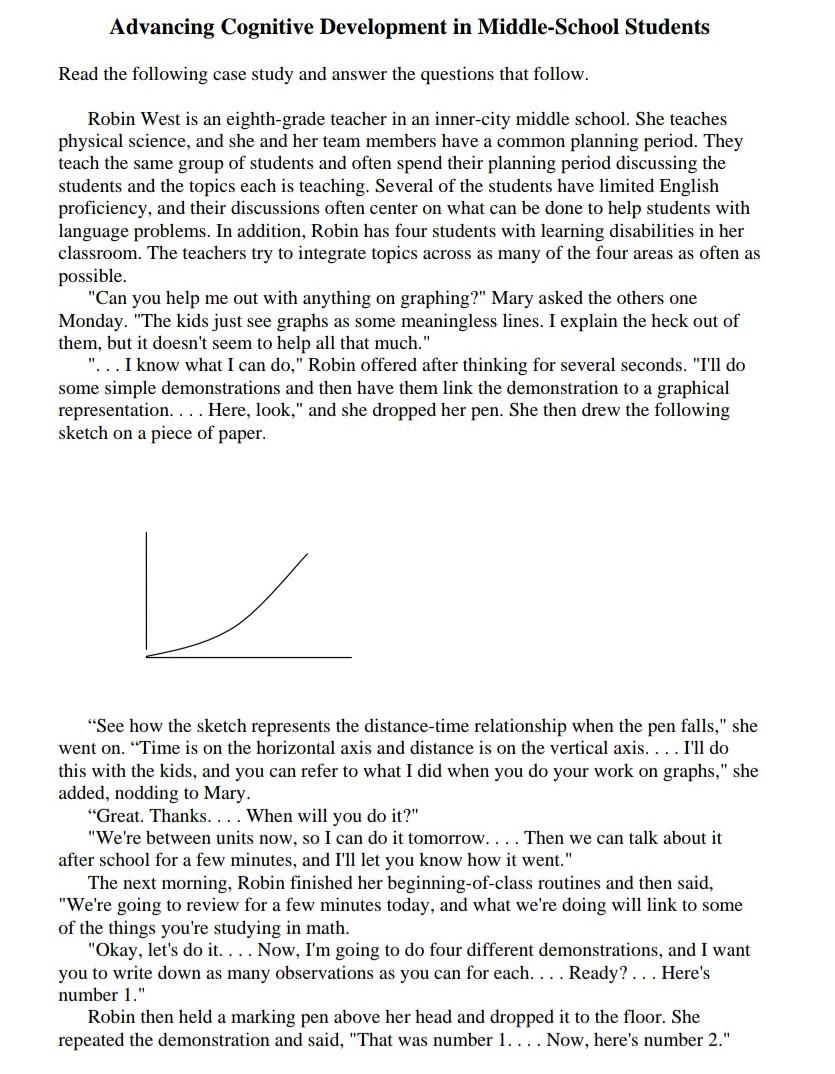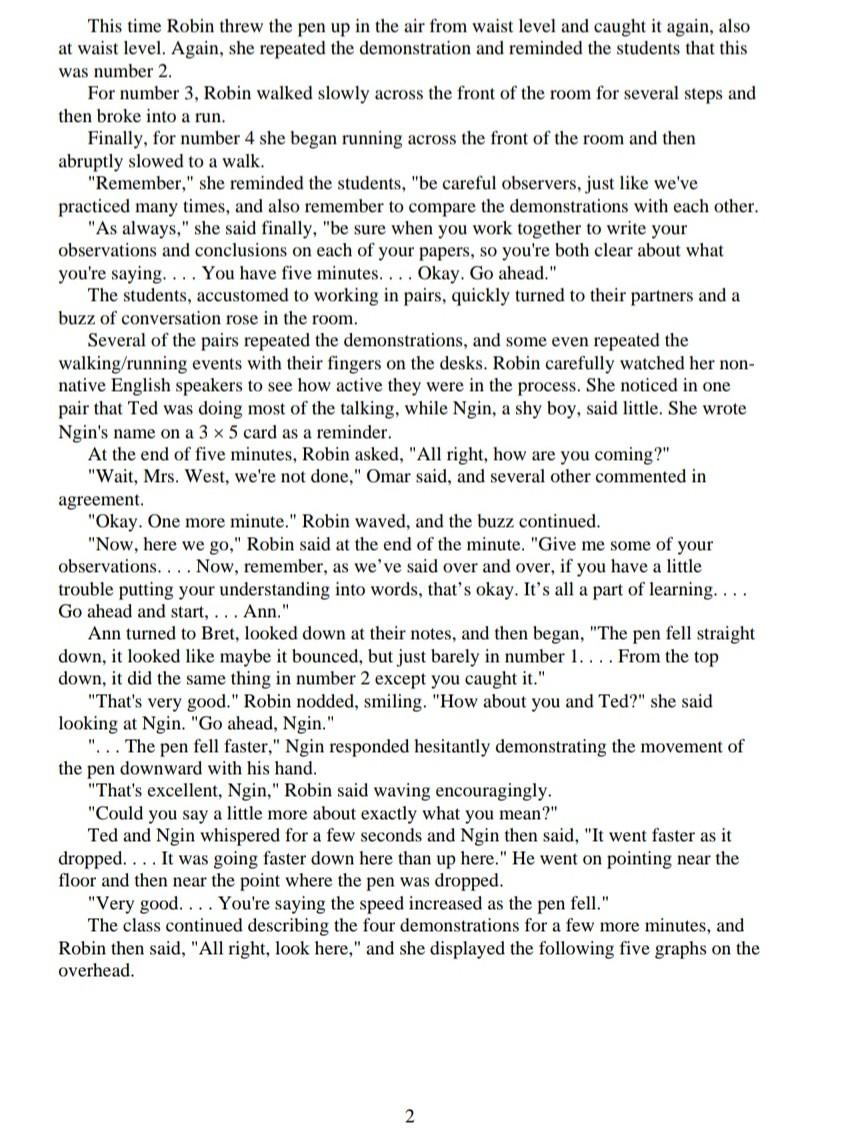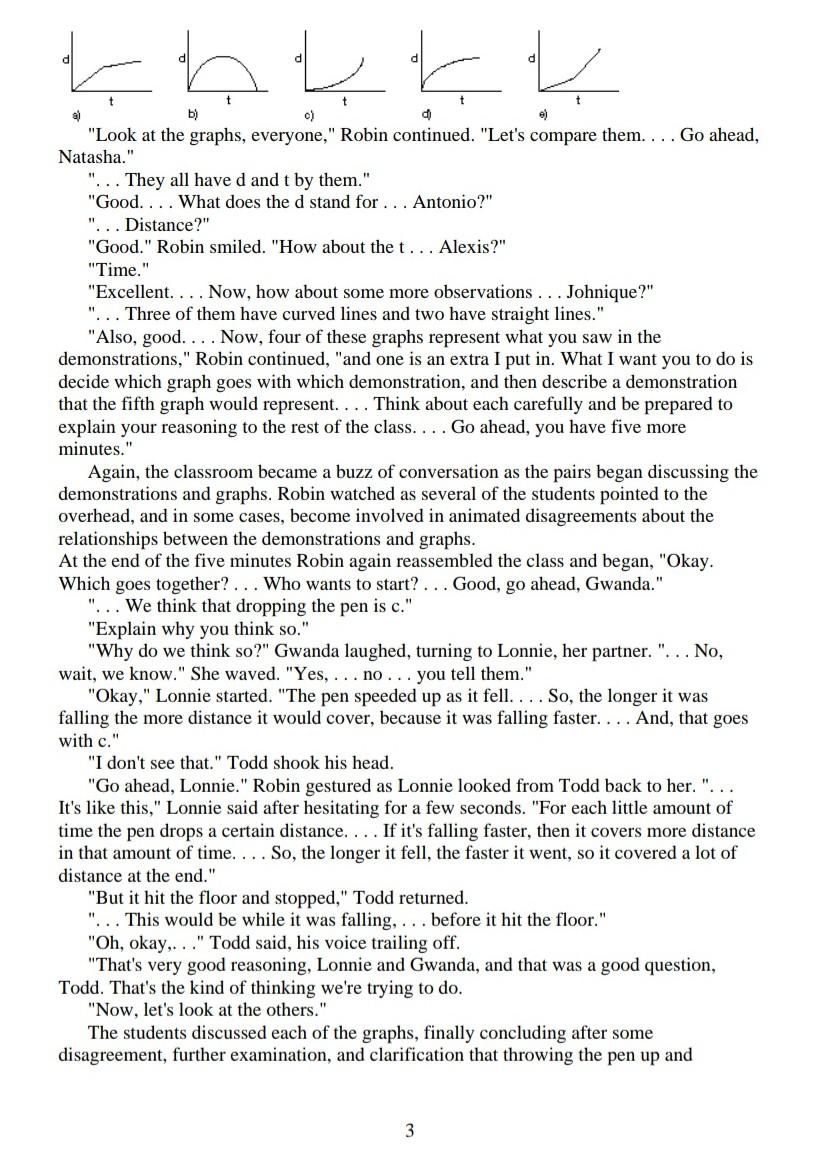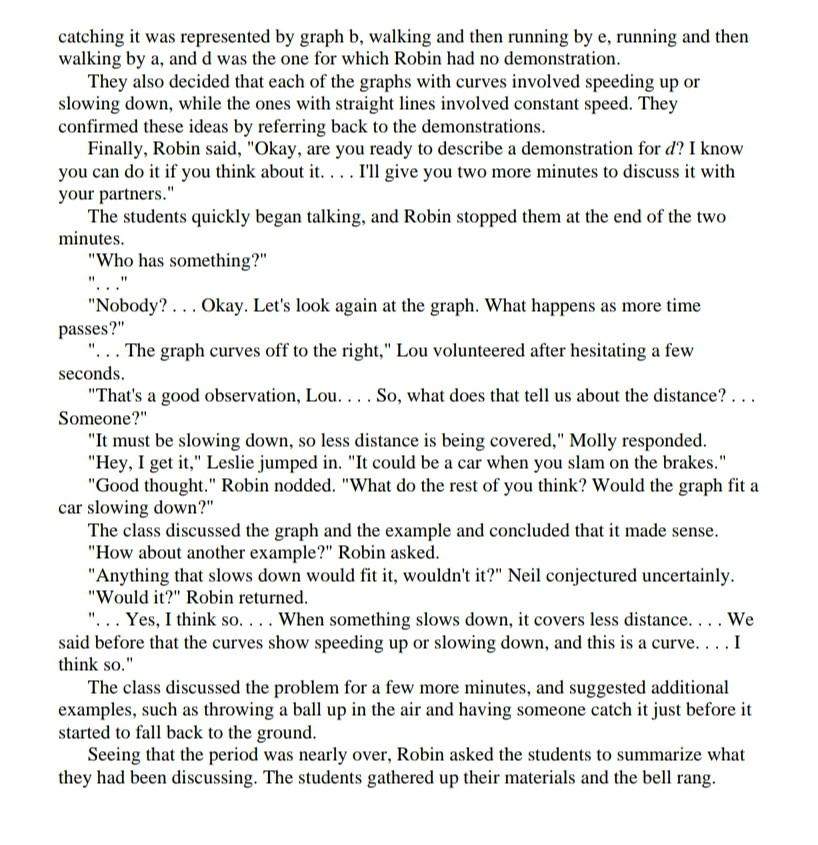Question
The attachments are supposed to help answer the questions (most of them have page numbers at the bottom scattered through out ...). 1. Based on
The attachments are supposed to help answer the questions (most of them have page numbers at the bottom scattered through out...). 1. Based on what you saw in the lesson, at which of Piaget's stages of development did Robin assume her students were thinking? 2. Early in their conversation Mary asked, "Can you help me out with anything on graphing?.. .

The kids just see graphs as some meaningless lines. I explain the heck out of them, but it doesn't seem to help all that much." Based on 3. Piaget's work, how can you explain the fact that the kids "see graphs as some meaningless lines"? 4. Based on what you saw in the lesson, how would you assess Robin's lesson in terms of its effectiveness for promoting language development?

4. In what ways does Robin's lesson reflect her use of concepts from Piaget's theory? 5. In what ways does Robin's work with her students reflect her use of concepts from Vygotsky's theory?


Advancing Cognitive Development in Middle-School Students Read the following case study and answer the questions that follow. Robin West is an eighth-grade teacher in an inner-city middle school. She teaches physical science, and she and her team members have a common planning period. They teach the same group of students and often spend their planning period discussing the students and the topics each is teaching. Several of the students have limited English proficiency, and their discussions often center on what can be done to help students with language problems. In addition, Robin has four students with learning disabilities in her classroom. The teachers try to integrate topics across as many of the four areas as often as possible. "Can you help me out with anything on graphing?" Mary asked the others one Monday. "The kids just see graphs as some meaningless lines. I explain the heck out of them, but it doesn't seem to help all that much." "... I know what I can do," Robin offered after thinking for several seconds. "I'll do some simple demonstrations and then have them link the demonstration to a graphical representation. . . . Here, look," and she dropped her pen. She then drew the following sketch on a piece of paper. U "See how the sketch represents the distance-time relationship when the pen falls," she went on. "Time is on the horizontal axis and distance is on the vertical axis. ... I'll do this with the kids, and you can refer to what I did when you do your work on graphs," she added, nodding to Mary. "Great. Thanks. ... When will you do it?" "We're between units now, so I can do it tomorrow.... Then we can talk about it after school for a few minutes, and I'll let you know how it went." The next morning, Robin finished her beginning-of-class routines and then said, "We're going to review for a few minutes today, and what we're doing will link to some of the things you're studying in math. "Okay, let's do it. ... Now, I'm going to do four different demonstrations, and I want you to write down as many observations as you can for each. ... Ready?... Here's number 1." Robin then held a marking pen above her head and dropped it to the floor. She repeated the demonstration and said, "That was number 1. ... Now, here's number 2." This time Robin threw the pen up in the air from waist level and caught it again, also at waist level. Again, she repeated the demonstration and reminded the students that this was number 2. For number 3, Robin walked slowly across the front of the room for several steps and then broke into a run. Finally, for number 4 she began running across the front of the room and then abruptly slowed to a walk. "Remember," she reminded the students, "be careful observers, just like we've practiced many times, and also remember to compare the demonstrations with each other. "As always," she said finally, "be sure when you work together to write your observations and conclusions on each of your papers, so you're both clear about what you're saying. ... You have five minutes. ... Okay. Go ahead." The students, accustomed to working in pairs, quickly turned to their partners and a buzz of conversation rose in the room. Several of the pairs repeated the demonstrations, and some even repeated the walking/running events with their fingers on the desks. Robin carefully watched her non- native English speakers to see how active they were in the process. She noticed in one pair that Ted was doing most of the talking, while Ngin, a shy boy, said little. She wrote Ngin's name on a 3 x 5 card as a reminder. At the end of five minutes, Robin asked, "All right, how are you coming?" "Wait, Mrs. West, we're not done," Omar said, and several other commented in agreement "Okay. One more minute." Robin waved, and the buzz continued. "Now, here we go," Robin said at the end of the minute. "Give me some of your observations.... Now, remember, as we've said over and over, if you have a little trouble putting your understanding into words, that's okay. It's all a part of learning. ... Go ahead and start, . . . Ann." Ann turned to Bret, looked down at their notes, and then began, "The pen fell straight down, it looked like maybe it bounced, but just barely in number 1.... From the top down, it did the same thing in number 2 except you caught it." "That's very good." Robin nodded, smiling. "How about you and Ted?" she said looking at Ngin. "Go ahead, Ngin." "... The pen fell faster," Ngin responded hesitantly demonstrating the movement of the pen downward with his hand. "That's excellent, Ngin," Robin said waving encouragingly. "Could you say a little more about exactly what you mean?" Ted and Ngin whispered for a few seconds and Ngin then said, "It went faster as it dropped. ... It was going faster down here than up here." He went on pointing near the floor and then near the point where the pen was dropped. "Very good. ... You're saying the speed increased as the pen fell." The class continued describing the four demonstrations for a few more minutes, and Robin then said, "All right, look here," and she displayed the following five graphs on the overhead. 2 t t a) c) e) " b) "Look at the graphs, everyone," Robin continued. "Let's compare them. ... Go ahead, Natasha." "... They all have d and t by them." "Good.... What does the d stand for ... Antonio?" "... Distance?" "Good." Robin smiled. "How about the t... Alexis?" "Time." "Excellent. ... Now, how about some more observations ... Johnique?" "... Three of them have curved lines and two have straight lines." "Also, good. ... Now, four of these graphs represent what you saw in the demonstrations," Robin continued, "and one is an extra I put in. What I want you to do is decide which graph goes with which demonstration, and then describe a demonstration that the fifth graph would represent. ... Think about each carefully and be prepared to explain your reasoning to the rest of the class. ... Go ahead, you have five more minutes." Again, the classroom became a buzz of conversation as the pairs began discussing the demonstrations and graphs. Robin watched as several of the students pointed to the overhead, and in some cases, become involved in animated disagreements about the relationships between the demonstrations and graphs. At the end of the five minutes Robin again reassembled the class and began, "Okay. Which goes together?... Who wants to start? ... Good, go ahead, Gwanda." "... We think that dropping the pen is c." "Explain why you think so." "Why do we think so?" Gwanda laughed, turning to Lonnie, her partner. "... No, wait, we know." She waved. "Yes, ... no... you tell them." "Okay," Lonnie started. "The pen speeded up as it fell. ... So, the longer it was falling the more distance it would cover, because it was falling faster. . . . And, that goes with c." "I don't see that." Todd shook his head. "Go ahead, Lonnie." Robin gestured as Lonnie looked from Todd back to her. ". It's like this," Lonnie said after hesitating for a few seconds. "For each little amount of time the pen drops a certain distance. ... If it's falling faster, then it covers more distance in that amount of time. ... So, the longer it fell, the faster it went, so it covered a lot of distance at the end." "But it hit the floor and stopped," Todd returned. "... This would be while it was falling, ... before it hit the floor." "Oh, okay,..." Todd said, his voice trailing off. "That's very good reasoning, Lonnie and Gwanda, and that was a good question, Todd. That's the kind of thinking we're trying to do. "Now, let's look at the others." The students discussed each of the graphs, finally concluding after some disagreement, further examination, and clarification that throwing the pen up and 3 catching it was represented by graph b, walking and then running by e, running and then walking by a, and d was the one for which Robin had no demonstration. They also decided that each of the graphs with curves involved speeding up or slowing down, while the ones with straight lines involved constant speed. They confirmed these ideas by referring back to the demonstrations. Finally, Robin said, "Okay, are you ready to describe a demonstration for d? I know you can do it if you think about it. ... I'll give you two more minutes to discuss it with your partners." The students quickly began talking, and Robin stopped them at the end of the two minutes. "Who has something?" passes?" "Nobody?... Okay. Let's look again at the graph. What happens as more time "... The graph curves off to the right," Lou volunteered after hesitating a few seconds. "That's a good observation, Lou.... So, what does that tell us about the distance?... Someone?" "It must be slowing down, so less distance is being covered," Molly responded. "Hey, I get it," Leslie jumped in. "It could be a car when you slam on the brakes." "Good thought." Robin nodded. "What do the rest of you think? Would the graph fit a car slowing down?" The class discussed the graph and the example and concluded that it made sense. "How about another example?" Robin asked. "Anything that slows down would fit it, wouldn't it?" Neil conjectured uncertainly. "Would it?" Robin returned. "... Yes, I think so. ... When something slows down, it covers less distance. ... We said before that the curves show speeding up or slowing down, and this is a curve....I think so." The class discussed the problem for a few more minutes, and suggested additional examples, such as throwing a ball up in the air and having someone catch it just before it started to fall back to the ground. Seeing that the period was nearly over, Robin asked the students to summarize what they had been discussing. The students gathered up their materials and the bell rang
Step by Step Solution
There are 3 Steps involved in it
Step: 1

Get Instant Access to Expert-Tailored Solutions
See step-by-step solutions with expert insights and AI powered tools for academic success
Step: 2

Step: 3

Ace Your Homework with AI
Get the answers you need in no time with our AI-driven, step-by-step assistance
Get Started


